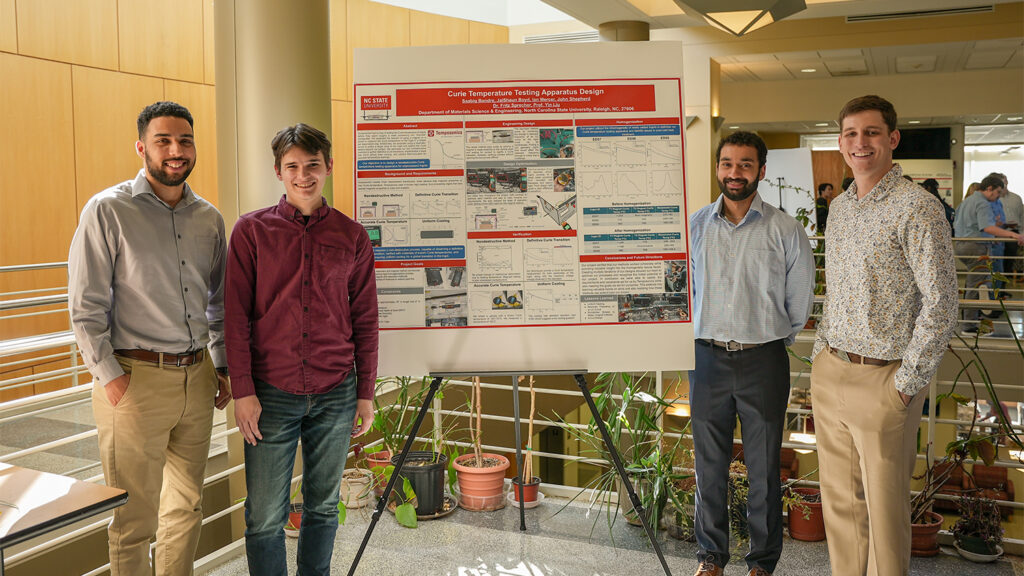When JaiShaun (Jai) Boyd decided to attend NC State University, he’d never before set foot in Raleigh.
“Since COVID was going on, there weren’t any tours going on [at NC State], and I decided, ‘I’m just gonna trust it’s fine,’” he said.
Four years later, Boyd is about to graduate with a B.S. in materials science and engineering (MSE), is working on his first research publication, and is preparing to again move somewhere he’s never been before. At the end of the summer, he’ll be driving across the country to start a master’s degree in electrochemical science and technology at the University of Oregon.
“I feel like the Oregon decision, it’s definitely the right move,” he said.
Boyd didn’t always see this path ahead for him.
At the beginning of his sophomore year, his older brother passed away. It was the first time he had lost someone close to him, and it was one of the toughest times of his life. He was living with grief while navigating a challenging academic degree program.
“Going to class was dreadful, and trying to be a productive student was really hard,” he said. “I even ended up failing Calculus 3 that semester. Another two bad semesters went by, and I realized that something had to change.
“I thought about my brother’s life, how it was cut short, and how nothing is guaranteed in life. I had to learn it was OK to be sad about his loss, but also that I couldn’t let this moment lead me in the wrong direction, and keep me down. This made me realize, I need to seize every opportunity and make the most of every moment, and never take a moment for granted again.”

Boyd started spending late nights in the library, and he went from worrying about failing his classes to earning a spot on the dean’s list his last three semesters.
He joined SciBridge, a club for students to build and send materials and equipment to schools in East Africa to grow discussion on sustainable energy development, and he learned to solder and build potentiostats, an electronic device that measures and controls the voltage difference between two electrodes.
He played on intramural sports teams, including the Solid-State Strikers, a soccer team formed by MSE classmates who bonded over signing up and playing in the competitive league despite having no previous soccer experience.

He attended MSE’s Friday research seminars and left them feeling as if he’d learned so much while also amazed by how much more there is to learn.
And most importantly for his path to graduate school, he started doing undergraduate research.
“… You should always seek out opportunities, and do anything you can with the time you are given,” he said. “Whether it be a job, school, or anything else in life, go for it.”
Seeing the world through materials
Boyd decided to major in materials science and engineering after taking E102: Grand Challenges of the 21st Century. As he learned about the 14 challenges, he thought that MSE opened up the widest range of possibilities.
“Regardless of what industry you’re going into, something stems from some material, and materials have properties you can change based on the structure,” he said.
During the second semester of his junior year, Boyd joined the Augustyn Research Group, run by Veronica Augustyn, the Jake and Jennifer Hooks Distinguished Scholar in Materials Science and Engineering, a University Faculty Scholar and an associate professor. The group “investigates materials at electrochemical interfaces for the development of clean-energy technologies.” Boyd is interested in electric vehicles and thought the group seemed like a good fit.

He worked on two projects, and over the summer, he hopes to publish a paper on the second project, which is focused on transition metal oxides and their effect on battery life. In the lab, he weighs out niobium oxide and molybdenum oxide, grinds them together, and puts them in a furnace to combine them. The material, which has a Wadsley-Roth crystallographic shear structure and is a good anode material for batteries, is then put on an electrode.
“We make slurry electrodes, so you can think of it as almost like a slushie,” he explained. “You put it on there, it’s a really thin film, and then you run your test.”
The research team is synthesizing new compositions of the same material to see how the amount of transition metals in the crystal structure affects the capacity and efficiency of the electrodes.

Through his graduate program, he will continue his focus on electrochemistry. The program starts with six or nine months of classes, depending on if he chooses the accelerated program, followed by a paid nine-month internship, which helps offset the cost of graduate school. After earning his master’s degree, he’ll decide between going into industry or continuing on for a Ph.D.
“Just like MSE, with electrochemistry, there are a bunch of different things you can do with it,” he said. “You can do energy storage, like batteries and fuel cells. Corrosion … There’s carbon emission capture, which I think is cool. Stuff with medical devices … Going to research seminars and meetings, you learn all the possibilities.”


Boyd’s graduate program starts in September, and he’ll be making a cross-country road trip later this summer. He made one previously with a friend who was moving to California, and he’s looking forward to stopping in new cities on his way to a school and program he’s trusting will be fine and is excited to attend.
“Continuing to learn about electrochemistry at UO is going to be awesome knowing that I will make the fullest of it,” he said.

This post was originally published in College of Engineering News.
